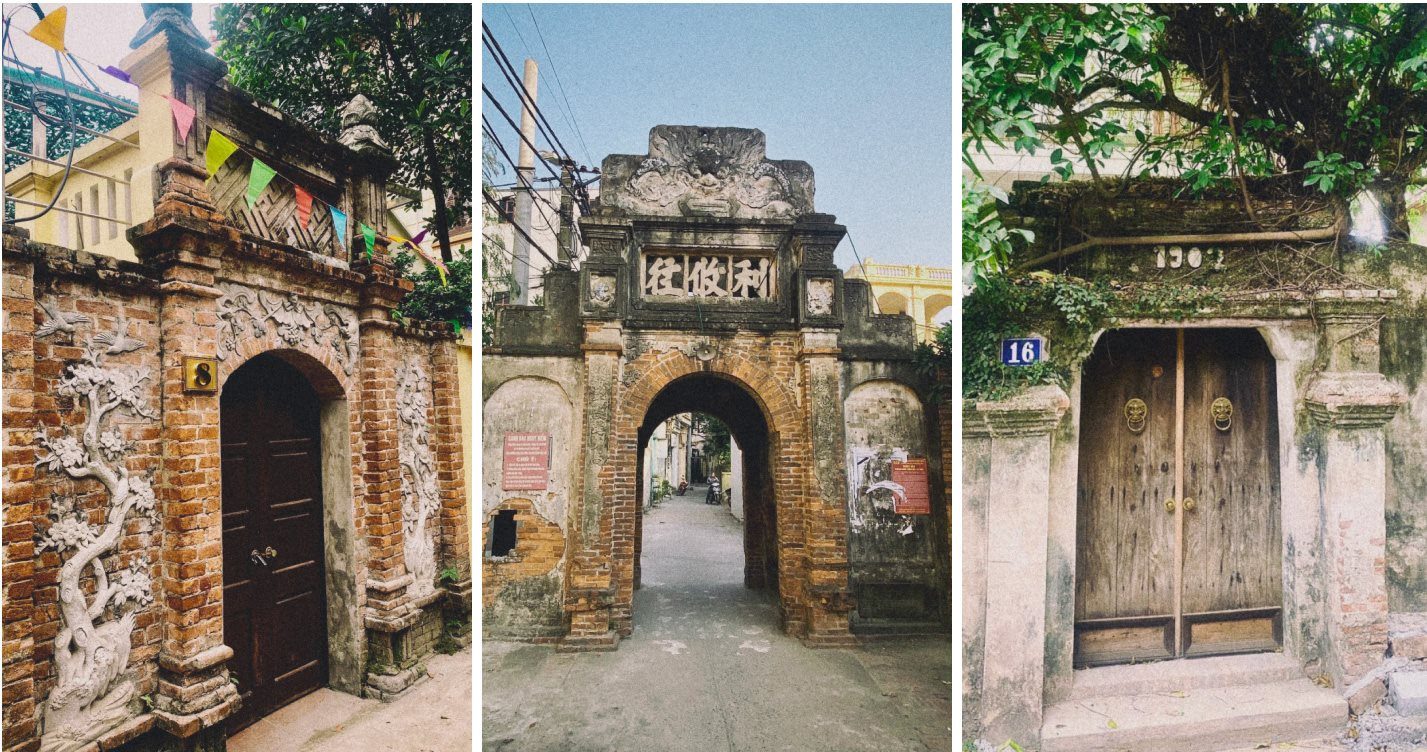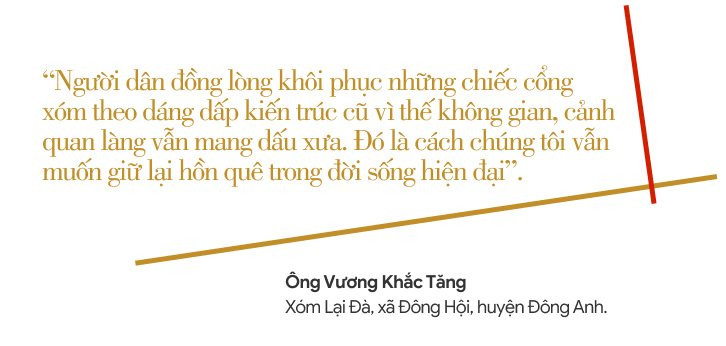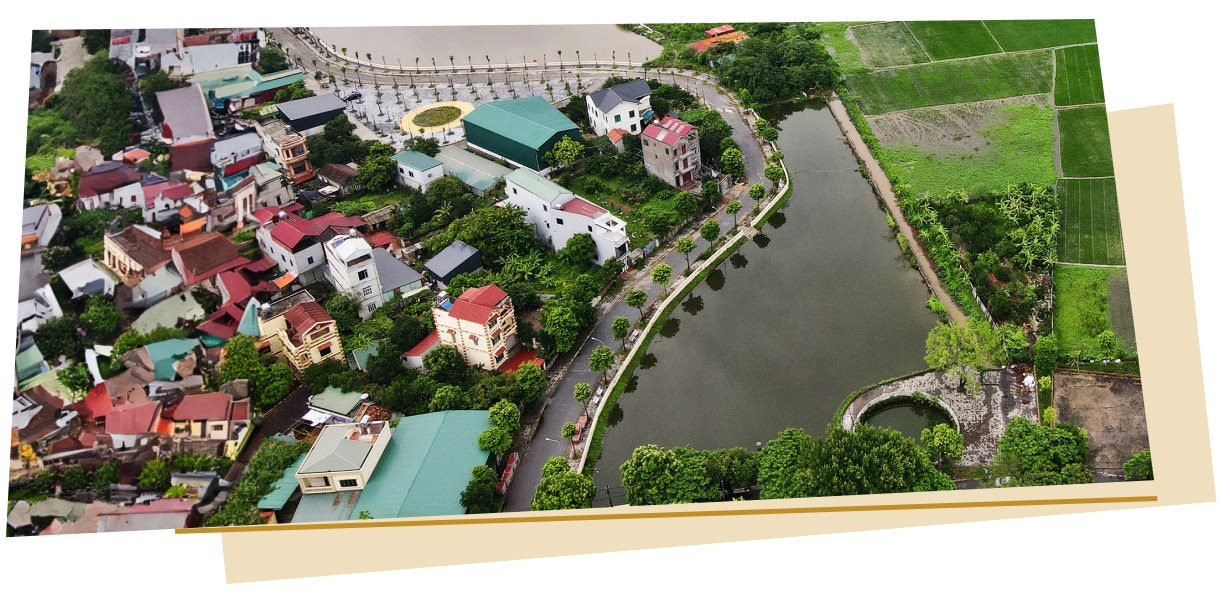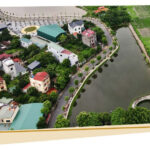Participating in the “6th Cultural Development and Elegant and Civilized Hanoian Building Press Awards 2023” competition, the team of authors including Tran Hong Van, Hoang Le Quyen, Doan Anh Tuan, and Nguyen Huu Tiep from Hanoimoi newspaper remarkably secured the A prize with their work “Rural Architecture: What Lies Ahead in the Future?” for five consecutive parts. The Hanoi Department of Culture and Sports’ Electronic Information Portal is honored to introduce the fourth part of this piece to our extensive readership!

Modern rural construction ultimately aims to enhance rural life and bring happiness to farmers. The transformation from farmers to urban residents is a lengthy and persistent movement, but it is also the core to ensure that rural areas maintain their unique identity despite adopting a new look.
The “urban storm” sweeping into rural areas is an inevitable development, but it also brings undesired consequences for rural development planning. Many farmlands suddenly fall within urban planning areas, becoming urban zones with cultural and entertainment facilities. Many “mud-footed” farmers overnight become millionaires by selling their land. The relatively affluent economic conditions lead to changes in the lifestyle of many families.
The Secretary of the Party Committee and Head of the Fatherland Front Committee of Duong Da Hamlet (Duong Xa Commune, Gia Lam District) Phung Dac Xuong reflects somberly; rural land has become “golden inches.” By merely selling land, farmers can become wealthy. With money, people build new houses, and everyone wants their house to be tall and spacious. Whether their home harmonizes with the overall village or not is a concern for few. Cultural behaviors have changed accordingly, with less communal interactions, and people tend to keep to themselves.

Many village gates and traditional houses are still highly esteemed and preserved by the local residents.
From an architectural planning perspective, economic conditions, and the mindset of the people, all play a crucial role in determining the preservation of traditional house architecture and the architectural landscape of each village or hamlet. In an extensive discussion with us, architect Nguyen Luan pointed out that the architectural landscape of rural villages mostly preserves public architectural ensembles like communal houses, temples, pagodas, village gates, and sometimes ancient trees and wells. However, the architectural style of houses, being personal property, depends largely on how individuals want to preserve and maintain them.
“People who appreciate tradition will build houses in the old style, while those inclined toward modernity will mimic the construction seen in large urban areas. Therefore, to change the mindset of the people, localities should provide training, guidance, and promote traditional-spirit-inspired house designs using modern, suitable materials,” said architect Nguyen Luan.
Undeniably, life in rural areas is undergoing significant changes. Many localities are making efforts to establish new lifestyle movements to rejuvenate living spaces for residents, fostering a deeper connection to their homeland, village spirit, community solidarity, and sharing. Movements like “Bright – Green – Clean – Beautiful,” Cultural Residential Groups and Cultural Families are spreading widely, creating a vibrant rural cultural life and a more civilized atmosphere.
In the midst of the transformations in rural areas, Nguyen Ba Hoan, Vice Chairman of the People’s Committee of Yen So Commune (Hoai Duc District), shared that the commune has 9 hamlets, all equipped with cultural houses for regular cultural activities.
“People who love their hometown and take pride in the land they live on are the ones who will wholeheartedly preserve the essence and what they already have. In our efforts to maintain the old architectural landscape, we are working together with the people to preserve historical sites. The commune has also planned a 1.4-hectare area for additional construction in the vicinity of the Quan Gia communal house to promote tourism,” stated Nguyen Ba Hoan.
Also, with the pride of being the bright spot in the “newly elevated rural areas” and moving towards the “exemplary new rural model,” Nguyen Xuan Viet, the cultural official of Ha Mo Commune (Dan Phuong District), revealed that the locality is planning to restore certain landscape and architectural spaces of the old rural village to attract experiential tourists. Initiatives include recreating the sloping brick road and organizing rural markets.
“Ha Mo has been recognized as a city-level tourist destination. People are gradually becoming more aware of community tourism. Alongside the improvement of behavioral skills, restoring and preserving the values of old landscapes and architecture are receiving more emphasis,” expressed Nguyen Xuan Viet.

In the quest to rediscover the distinctive architectural imprints and contemporary village customs, we have encountered numerous models of both old and new rural architecture that are making a significant impact. This is a collaborative effort between the government and the local populace to construct a cultural and architectural space that preserves its unique essence. These models can be seen as benchmarks for safeguarding rural landscapes, architecture, and culture in modern life.

The Lai Da village gate was reconstructed in March 2011, remaining faithful to the architectural style of its original gate dating back 200 years.
Lai Da, located in Dong Hoi commune, is one of the ancient villages in Dong Anh, still maintaining its ancient charm through harmonious village and house architecture. This village has been recognized as a city-level cultural village since 2007.
At the entrance of the village, the gate was reconstructed in March 2011, staying true to the design of the original gate from two centuries ago. What makes Lai Da particularly appealing is its preservation of several communal gates, along with numerous houses featuring ancient architecture and a cluster of communal structures like communal houses, temples, and pagodas.
According to the recollections and notes of Mr. Vuong Khac Tang, the communal gates in Lai Da were built between 1945-1951. Today, Lai Da still retains two ancient gates, while the rest were restored with the collaborative efforts of the local residents who contributed both labor and materials to recreate them based on a shared design.
“The community came together to restore these communal gates following the old architectural style, preserving the village’s atmosphere and landscape with a touch of antiquity. This is our way of retaining the soul of our homeland in modern life,” explained Mr. Tang.

A notable landscape feature in Lai Da that lingers in our memory is the narrow alleys, flanked by moss-covered brick walls, leading to each family’s compound. It’s not challenging to find houses with spacious yards, gardens, three-roof-tile wooden houses, gracefully curved entrance gates adorned with subtle carvings, and aged Han script inscriptions on the faded roofs. In the gardens and courtyards, fruit trees, ornamental plants, and harmoniously coexisting animals create a simple yet emotionally rich ambiance.
.jpg)
In contrast to Lai Da, the commune of Duong Xa in Gia Lam district stands out as a place fostering innovation in creating a harmonious landscape between tradition and modernity.
Since the emergence of the Vinhome Ocean Park urban area, the rural scenery and lifestyle in Duong Xa have undergone significant transformations. A noteworthy development is the establishment of the first “smart village” in Hanoi at Thuan Quang hamlet. Cameras have been strategically installed along various roads to facilitate the management of village activities and life. Free wifi networks in public areas offer numerous benefits to residents. Historical sites and landmarks have been equipped with QR codes for easy information retrieval by locals and tourists. The commune has also launched a website and social media accounts to promote local agricultural products.

The essence of a rural village would lose its distinctive charm without communal gates and village entrances. According to Vice Chairwoman of the People’s Committee of Duong Xa Commune, Pham Thi Thuy, the local authorities are actively disseminating information and encouraging residents to preserve traditional structures such as communal gates, house gates, and traditional three-roof-tile houses. Additionally, the commune has undertaken the documentation and preservation of these architectural structures through photography for future reference. Following the successful pilot of the “smart hamlet” model in Thuan Quang, the commune plans to expand this initiative to other hamlets.
Discussing matters related to rural architectural planning, Phung Thi Hoai Huong, Head of the Office of Culture and Information of Gia Lam District, mentioned that while implementing criteria for district development into a city, alongside building culturally rich urban living, the district has devised plans for each area to safeguard the architectural landscape. The objective is to ensure that as the commune develops into an urban ward, it doesn’t lose its unique identity. For instance, in the ancient pottery village of Bat Trang, high-rise projects will not be approved, and residents are educated against independently altering the village’s architectural landscape.
In the whirlwind of urbanization, preserving ancient wells poses a significant challenge.
With the mindset of a locality at the forefront of constructing Hanoi’s “new exemplary rural” areas, the Vice Chairwoman of the People’s Committee of Dan Phuong District, Dao Thi Hong, informed that the district’s planning includes provisions for reserving land for future development. They aim to establish a system of canals, greenery surrounding ancient villages, and cultural landmarks.
“In the current landscape of ancient rural architecture, which is diminishing, we will strive to construct green architectural landscapes, preserve ponds, and canal banks because these are distinctive features of Dan Phuong,” stated Ms. Dao Thi Hong.
The joyful anecdotes and bright spots we encountered during our survey in rural areas only fueled our determination to find answers to the question: How can we achieve smooth, minimally disruptive, and reasonable transformations in the process of rural urbanization?
Tran Hong Van, Hoang Le Quyen, Doan Anh Tuan, and Nguyen Huu Tiep
Bài 4: Yêu quê thì sẽ còn quê (hanoimoi.vn)

